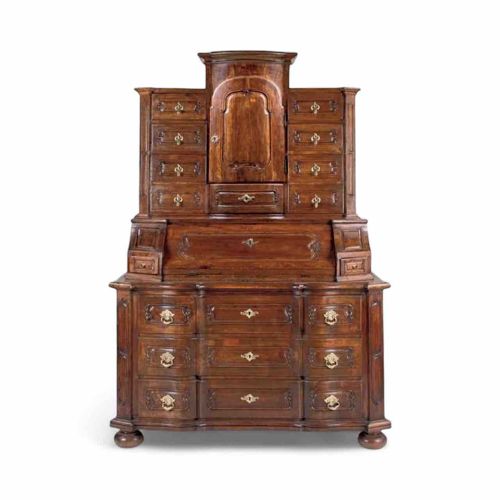
Austrian Brass-Mounted Stained Fruitwood Bureau Cabinet
This is an Austrian brass-mounted stained fruitwood bureau cabinet dating around the mid-18th century, specifically circa 1750. The piece is panelled overall, showcasing a rich, dark stained fruitwood finish that highlights the natural grain of the wood. It features a distinctive bow-fronted molded cornice atop the upper section. The upper part of the cabinet is highly organized, with a central door flanked by three drawers on each side, along with a long drawer situated above a hinged flap. This flap, when opened, reveals a fitted interior, and is further flanked by two additional drawers, suggesting a well-thought-out design for storage and workspace. The base of the cabinet is concave-fronted and waved, comprising three long drawers, all supported by bun feet. The brass mounts, likely original or period-appropriate, serve as both decorative elements and functional hardware for the numerous drawers and doors, providing an elegant contrast to the dark wood. The overall construction appears robust, demonstrating quality craftsmanship typical of the period. While specific condition issues such as wear, damage, or repairs are not overtly visible from the provided image, the description notes that the piece has been 'remounted,' which could refer to the brass hardware or structural components. The antique nature of the piece suggests an expected level of patina consistent with its age. This bureau cabinet exhibits characteristics of Rococo or Late Baroque styles prevalent in Austrian furniture during the mid-18th century, with its curved fronts and elaborate organization. Its provenance from a Christie's auction in 2007, lot 228, further indicates its recognized value and historical significance.
AI-Generated Appraisal Disclaimer
Estimated Value
$35,000-55,000
Basic Information
Category
Furniture
Appraised On
December 3, 2025
Estimated Value
$35,000-55,000
Additional Details Provided By Owner
User Provided Information
AN AUSTRIAN BRASS-MOUNTED STAINED FRUITWOOD BUREAU CABINET MID 18TH CENTURY. PANELLED OVERALL, THE BOW-FRONTED MOULDED CORNICE WITH ONE CENTRAL DOOR, FLANKED BY THREE DRAWERS TO EACH SIDE AND A LONG DRAWER ABOVE A HINGED FLAP ENCLOSING A FITTED INTERIOR, FLANKED BY TWO FURTHER DRAWERS. THE CONCAVE FRONTED AND WAVED BASE WITH THREE LONG DRAWERS, ON BUN FEET, REMOUNTED. CIRCA 1750. 52" W X 4'4" H X 25" . PURCHASED AT CHRISTIE’S AUCTION SALE 2734, European Noble and Private Collections IN APRIL 2007, LOT 228.
Item Description
This is an Austrian brass-mounted stained fruitwood bureau cabinet dating around the mid-18th century, specifically circa 1750. The piece is panelled overall, showcasing a rich, dark stained fruitwood finish that highlights the natural grain of the wood. It features a distinctive bow-fronted molded cornice atop the upper section. The upper part of the cabinet is highly organized, with a central door flanked by three drawers on each side, along with a long drawer situated above a hinged flap. This flap, when opened, reveals a fitted interior, and is further flanked by two additional drawers, suggesting a well-thought-out design for storage and workspace. The base of the cabinet is concave-fronted and waved, comprising three long drawers, all supported by bun feet. The brass mounts, likely original or period-appropriate, serve as both decorative elements and functional hardware for the numerous drawers and doors, providing an elegant contrast to the dark wood. The overall construction appears robust, demonstrating quality craftsmanship typical of the period. While specific condition issues such as wear, damage, or repairs are not overtly visible from the provided image, the description notes that the piece has been 'remounted,' which could refer to the brass hardware or structural components. The antique nature of the piece suggests an expected level of patina consistent with its age. This bureau cabinet exhibits characteristics of Rococo or Late Baroque styles prevalent in Austrian furniture during the mid-18th century, with its curved fronts and elaborate organization. Its provenance from a Christie's auction in 2007, lot 228, further indicates its recognized value and historical significance.
Get Your Items Appraised
Instant estimates of your treasures with AI-powered instant appraisals